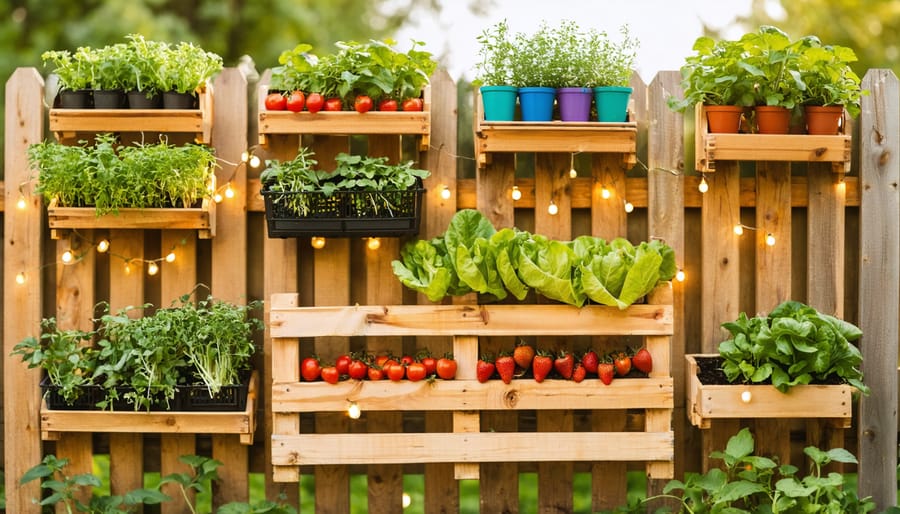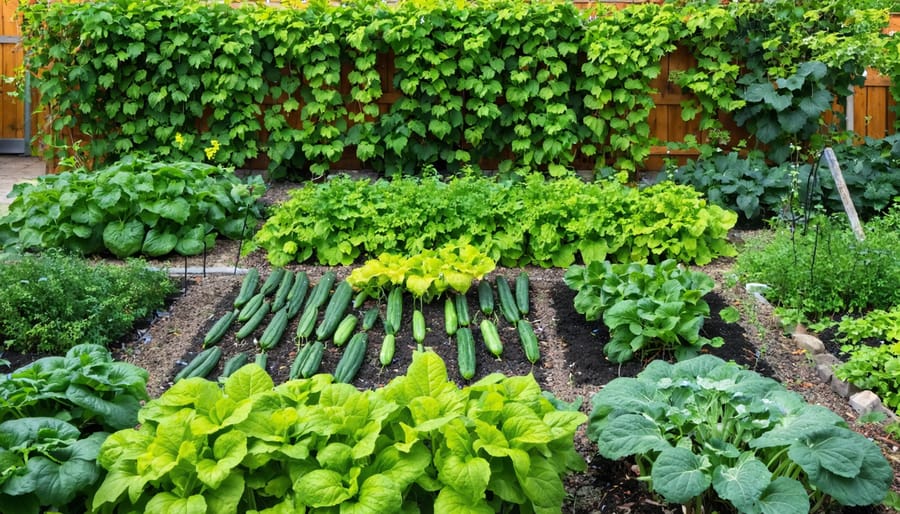Transform your outdoor space into a self-maintaining garden design by grouping plants with similar water needs together, creating defined planting zones that practically care for themselves. Position tough, spreading perennials like Russian sage, black-eyed susans, and ornamental grasses as anchors throughout the space, naturally suppressing weeds while providing year-round structure. Layer deep-rooted plants with shallow-rooted companions to maximize soil coverage and minimize maintenance, such as pairing coneflowers with creeping thyme. Select native perennials adapted to your specific climate zone—they thrive with minimal intervention while supporting local pollinators and creating a naturally balanced ecosystem. These strategic choices form the foundation of a garden that delivers stunning blooms and seasonal interest without demanding constant attention, perfect for busy gardeners who want lasting beauty without the endless maintenance.
Smart Design Principles for Easy-Care Perennial Gardens
Plant Grouping Strategies
Strategic plant grouping is the secret to creating a low-maintenance garden that looks stunning year-round. Start by placing taller plants at the back of borders and shorter ones in front, creating natural layers that require minimal pruning to maintain their shape. Group plants with similar water and sunlight needs together to streamline watering routines and ensure everyone thrives in their spot.
Consider planting in drifts of odd numbers (3, 5, or 7 plants) rather than single specimens. This approach not only creates visual impact but also helps suppress weeds naturally through dense coverage. When plants grow together in harmonious groups, they support each other and require less individual attention.
Another clever strategy is to mix plants with different blooming seasons. By combining early spring bloomers with summer performers and late-season stars, you’ll enjoy continuous color while maintaining the same space. Include evergreen plants as anchors to provide structure throughout the year.
Mass planting of ground covers between larger perennials helps eliminate bare spots where weeds might take hold. Remember to leave enough space between plants to account for their mature size – proper spacing reduces competition for resources and minimizes the need for division or replanting.

Space Planning and Garden Zones
Effective garden zoning is the secret to creating a low-maintenance paradise that’s both beautiful and manageable. Start by dividing your outdoor space into distinct zones based on maintenance needs and growing conditions. As you transform your garden space, group plants with similar water and sunlight requirements together to streamline care routines.
Consider creating these essential zones:
– A focal point area with statement perennials that require minimal upkeep
– A natural wildflower section that thrives with little intervention
– A transitional zone between high-traffic areas and deeper garden beds
– Buffer zones using ground covers to reduce weeding
Place higher-maintenance plants near easy-access points like pathways or your home’s entrance. This strategic positioning makes regular care tasks more convenient. Position drought-tolerant plants farther from water sources, and group thirstier varieties closer to irrigation systems or natural water collection areas.
Leave adequate space between plants to reduce competition and minimize pruning needs. Remember to incorporate maintenance paths – they should be wide enough for your gardening tools and comfortable movement. This thoughtful organization will save countless hours of garden maintenance throughout the growing season.
Best Low-Maintenance Perennials for Year-Round Interest
Spring and Summer Stars
When it comes to creating a vibrant garden that thrives during the main growing season, several native plants for low maintenance gardens truly shine. Black-eyed Susans (Rudbeckia) are absolute champions, producing cheerful yellow blooms from June through September with virtually no intervention needed. These hardy flowers naturally resist pests and adapt well to various soil conditions.
Coneflowers (Echinacea) are another summer superstar, offering weeks of colorful blooms that attract butterflies and beneficial pollinators. Their sturdy stems rarely need staking, and they actually perform better with minimal interference. For reliable ground coverage, try Creeping Phlox, which creates a carpet of spring color and continues to provide attractive foliage throughout summer.
Salvia ‘May Night’ delivers striking purple spikes from late spring through summer, requiring nothing more than occasional deadheading to keep blooming. For those shady spots, Hostas remain the go-to choice, offering beautiful foliage in various patterns and sizes. Their only maintenance requirement is some slug protection in early spring.
Daylilies deserve special mention for their incredible resilience. These adaptable plants produce abundant blooms throughout summer, with each flower lasting just a day but being quickly replaced by new ones. Different varieties can be selected to create successive waves of color throughout the season.
For late-summer drama, try Sedum ‘Autumn Joy’, which develops fascinating flower heads that start pale green, transition to pink, and finally mature to rich bronze. These structural plants look great even in winter, providing year-round interest with practically zero maintenance.

Fall and Winter Warriors
Just because your garden enters dormancy doesn’t mean it can’t remain visually striking throughout fall and winter. Several perennials excel at providing interest during these quieter seasons, making them invaluable additions to a low-maintenance garden design.
Ornamental grasses like Feather Reed Grass and Maiden Grass become spectacular focal points in autumn, with their golden plumes swaying gracefully in winter winds. These sturdy plants require virtually no maintenance and offer both movement and structure to the winter landscape.
Sedum ‘Autumn Joy’ transitions beautifully through the seasons, with its deep rose flower heads gradually darkening to rich bronze, then maintaining their shape through winter frost. The dried flower heads not only look stunning but also provide food for birds.
Consider incorporating plants with attractive seed heads, such as Echinacea (Coneflower) and Rudbeckia (Black-eyed Susan). Their dark centers create striking silhouettes against winter snow and provide natural food sources for wildlife. Similarly, Russian Sage maintains its silvery stems long after its flowers have faded, adding vertical interest to the winter garden.
For reliable winter color, Hellebores are outstanding choices. These evergreen perennials, often called Christmas Roses, bloom in late winter when most gardens are still dormant. Plant them near walkways or entrances where their nodding flowers can be easily appreciated.
Don’t forget about ornamental berries – Winterberry Holly loses its leaves but keeps its bright red berries throughout winter, creating vibrant splashes of color in an otherwise muted landscape. These hardy plants thrive with minimal care while providing crucial winter interest.
Time-Saving Garden Features
Smart Mulching Systems
A well-planned mulching system is the secret weapon of low-maintenance gardening, acting as your garden’s protective shield while reducing your workload. The key is to apply a 2-3 inch layer of organic mulch around your perennials, being careful not to pile it against plant stems or crown areas.
For the best results, use a combination of materials. Start with a layer of shredded leaves or grass clippings, followed by a more substantial material like wood chips or bark mulch. This dual-layer approach provides excellent weed suppression while allowing water to penetrate effectively.
Timing matters too. Apply mulch in early spring before weeds emerge, and refresh it in late fall to protect plant roots during winter. Choose darker-colored mulches for areas where you want to retain heat, particularly useful for early-season growth in cooler climates.
Consider using landscape fabric beneath your mulch in areas particularly prone to aggressive weeds. However, use this sparingly, as it can prevent beneficial organisms from enriching your soil naturally.
Smart tip: Create mulch basins around individual plants or plant groupings to direct water toward root zones, reducing water usage and maintenance time. Remember to leave a small gap around plant stems to prevent rot and disease issues.
For the most sustainable approach, create your own mulch by composting fallen leaves and garden trimmings. This not only saves money but also ensures a continuous supply of nutrient-rich mulch for your garden.
Efficient Irrigation Solutions
Setting up an efficient irrigation system is key to maintaining a low-maintenance perennial garden. Drip irrigation systems are the gold standard, delivering water directly to plant roots while minimizing waste and reducing weed growth. These systems can be connected to timers, allowing you to “set it and forget it” while ensuring your plants receive consistent moisture.
Consider installing a rain sensor with your irrigation system – it automatically prevents watering when nature does the job for you. Soaker hoses offer another excellent solution, especially for garden beds with dense plantings. Simply snake them through your garden beds, cover with mulch, and let them slowly release water exactly where it’s needed.
For those interested in sustainable gardening practices, installing a rain barrel system can help capture free water for your garden. Connect these to your drip system or soaker hoses for an eco-friendly irrigation solution. Adding a thick layer of organic mulch (2-3 inches) around your plants will significantly reduce water evaporation and keep soil moisture levels stable.
Zone irrigation planning is another smart strategy – group plants with similar water needs together. This prevents overwatering some plants while underwatering others. Consider incorporating moisture-retaining materials like water-storing crystals or coconut coir into your soil during planting to help maintain consistent moisture levels between watering sessions.
Remember, the goal is to create a system that maintains optimal soil moisture with minimal intervention on your part.

Seasonal Maintenance Schedule
Essential Tasks by Season
Maintaining a low-maintenance perennial garden still requires some attention throughout the year. Following these garden planning strategies by season will keep your garden thriving with minimal effort.
Spring (March-May):
Clear away winter debris and dead foliage once soil has thawed. Apply a fresh layer of compost around plants and add mulch to suppress weeds. Divide overcrowded perennials and relocate as needed. Check for any winter damage and prune affected areas.
Summer (June-August):
Remove spent blooms to encourage continued flowering, though this isn’t crucial for all species. Water deeply but infrequently, focusing on root zones. Pull any persistent weeds before they set seed. Monitor for pest issues, addressing them naturally when possible.
Fall (September-November):
Cut back spent foliage of deciduous perennials, leaving evergreen varieties and seed heads for winter interest and bird food. Add a fresh layer of compost and mulch to protect roots. Plant new perennials and divide existing ones if needed. Remove any diseased plant material.
Winter (December-February):
Let your garden rest, but check occasionally for winter damage after storms. Use this time to plan next year’s additions or changes. Heavy snow can actually insulate plants, so don’t worry about removing it unless branches are breaking. Avoid walking on frozen grass or garden beds.
Remember, these tasks are minimal compared to high-maintenance gardens, and many can be completed in short weekend sessions throughout each season.
Time-Saving Garden Tools
Having the right tools can transform your gardening experience from tedious to enjoyable. A quality pair of bypass pruners is essential for clean cuts on stems and branches, while a sturdy garden fork helps with soil preparation and dividing perennials. Invest in a long-handled spade with a comfortable grip – your back will thank you later!
For routine maintenance, a sharp hand trowel and a sturdy weeding tool are indispensable. Consider getting an ergonomic kneeling pad or garden stool to protect your knees during planting and weeding sessions. A well-designed leaf rake with adjustable tines makes cleaning up fallen leaves a breeze, especially around delicate plants.
Time-saving innovations like a self-coiling garden hose and automatic watering timer can significantly reduce your maintenance workload. Don’t forget about storage – a mobile garden cart or tool caddy keeps everything organized and within reach. For larger gardens, a wheelbarrow is invaluable for moving mulch, compost, or divided plants.
Remember, quality tools may cost more initially but will save you time and effort in the long run while making gardening more enjoyable.
Creating a low-maintenance perennial garden is a rewarding journey that combines beauty with practicality. By following the design principles and plant selection guidelines we’ve discussed, you can create a stunning outdoor space that thrives year after year with minimal effort. Remember to group plants with similar water and sunlight needs, incorporate native species, and use mulch generously to reduce weeding and water requirements.
Don’t be afraid to start small and expand your garden gradually as you become more comfortable with the maintenance routine. The key is to work with your local climate and soil conditions rather than against them. Consider the natural flow of your outdoor space and how you’ll interact with it throughout the seasons.
With thoughtful planning and the right plant choices, your low-maintenance perennial garden will provide years of enjoyment while leaving you with more time to actually enjoy it. Whether you’re an experienced gardener or just starting, now is the perfect time to begin creating your own sustainable and beautiful outdoor sanctuary. Take that first step today, and watch as your garden grows into a flourishing, easy-care landscape that brings joy season after season.




